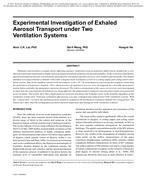Description
Pollutant concentration is a major factor affecting exposure. Expiratory process generates high velocity droplets for a very short period of time which leads to highly transient temporal and non-uniform concentration profiles. In the work described herein, spatial and temporal aerosol concentrations generated by a modeled expiratory process were studied experimentally. Two heated manikins were placed inside a chamber with either a displacement ventilation system or a ceiling supply and ceiling return ventilation system. One of the manikins emitted 0.05 micrometer (1.64 x 10–7 ft) monodisperse polystyrene microspheres mimicking the generation of expiratory droplets. Flow characteristics of expiratory process were investigated by a hot-film anemometry system before and after the momentary emission of aerosol. The relative orientations of the source-to-receiver were investigated to study how the concentration distribution was being affected. The dimensionless temporal concentration results were presented at six locations. The results show that a high-speed air jet easily penetrates the boundary layer of the manikin regardless of the ventilation system used. Transient ventilation effectiveness was also evaluated and compared for both ventilation systems. With the “counter flow” scenario the emitted particles tended to suspend in the mechanical ventilated chamber for a long period. The results also show that this arrangement promotes particle dispersion and mixing for both ventilation schemes.
Citation: IAQ Conference: IAQ 2010: Airborne Infection Control
Product Details
- Published:
- 2011
- File Size:
- 1 file , 640 KB
- Product Code(s):
- D-IAQ2010-C186-10




